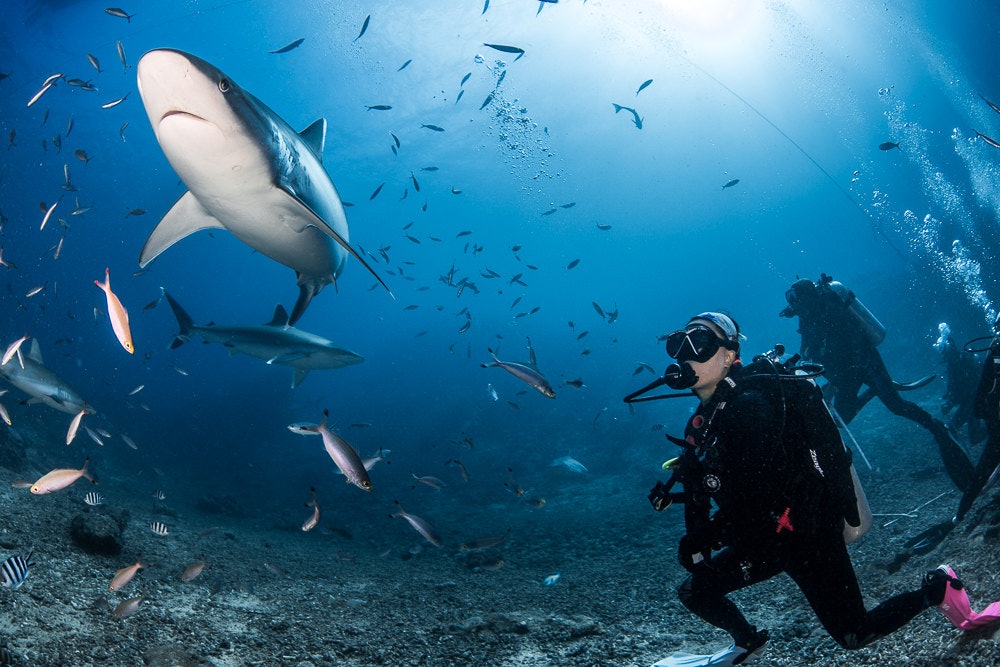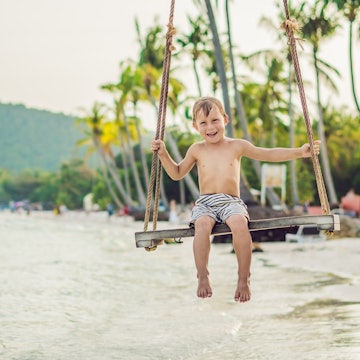

The sharks are often flanked by hoards of tropical fish © Christine Albanese
A 3.5-metre shark careens toward a group of divers, its powerful, tiger-striped body guided by an upturned snout and two beady eyes. This isn’t an attack – the tiger shark is merely curious – but the divers’ adrenaline surges all the same as they sink behind the rock wall they’re grasping. The shark cruises over and circles back to join bull, black tip, nurse and lemon sharks, along with of tropical fish, in a controlled and awe-inspiring feeding frenzy.
Welcome to Fiji’s Beqa (Be-nga) Lagoon, where the boldest of divers hang out with some of the world’s largest and most-feared predators.

Fiji’s shark diving history
Superlative shark diving encounters are possible in Fiji’s Beqa Lagoon thanks to the locals, who have been swimming with sharks for something like three thousand years. Shark-related stories and myths have been passed down through many generations of local families, and long before Christianity began to take hold, indigenous Fijians worshipped their very own shark god, Dakuwaqa, who was said to protect fishermen from dangers at sea.
Beqa Lagoon’s local shark wranglers accompany each dive boat to the feeding sites they’ve designed, and work as intermediaries beneath the sea, protecting the divers from the sharks and vice versa. They do this by positioning themselves between the divers and the sharks and using hand motions to signal to the sharks where food is available and where the sharks are not welcome. Although the sharks generally pay close attention to the signals and body language, those that do not may receive a manual redirection as a last resort. This – in conjunction with the protective rock wall – prevents the divers and sharks from accidentally colliding.

The wranglers feel at home in this fin-filled lagoon, a channel off the southern coast of Fiji’s main island Viti Levu encircled by a coral reef system. The waters are calm and clear year-round, and the wranglers are equally relaxed as they interact with the massive, toothy beasts that utterly terrify the vast majority of other humans around the planet. There is no instruction manual on how to do this; it’s simply a part of the culture that one Fijian teaches another who teaches another, a practice and a relationship being honed over time.
Diving Beqa Lagoon
There are eight species of shark present in Beqa Lagoon, and all of them are known to frequent the feeding sites. But most divers show up for a chance to commune with the notoriously feisty tiger and bull sharks.

Featuring distinctive vertical stripes and weighing up to 635kg, tiger sharks have woefully undiscerning palates and eat pretty much anything. And while humans aren’t officially part of the diet, they also aren't complete strangers to the insides of tiger shark stomachs. Bull sharks are smaller than tiger sharks, growing to only 230kg, but some experts consider them more dangerous to humans for their tendency to visit shallow, warm areas along with freshwater rivers and tributaries.

While both of these species can be spotted at any of the feeding sites around the lagoon, the tiger sharks seem most drawn to Cathedral, a site designed and maintained by Beqa Lagoon Resort. The site is located just a short boat ride from the resort and 20 metres below the surface. Divers descend along the contour of a reef and then settle behind a rock wall at the bottom, where thousands of fish, including schools of giant trevally, fusiliers and triggerfish, along with plenty of sharks, congregate for the feeding. Together they create a churning storm of undersea life, with sharks orbiting the chaos and occasionally darting through.
Two reputable, dive operators, Beqa Adventure Divers and Aqua-trek are based in Pacific Harbour and offer shark dives in the lagoon. The fish frenzy at their sites is similar to that of Cathedral, but gargantuan bull sharks (rather than the tigers) tend to dominate the action. To reach the feeding, divers descend over coral reefs and near shipwrecks placed to help weaken the current. Divers line up behind a wall to witness the spectacle, during which the bull sharks arrive quickly and seize the fish heads on offer. Occasionally, a bunch of wily silvertip sharks materialise and zoom around, and every so often, a moray eel, sea turtle or manta ray might also drift into the mix.
The trips each involve two shark dives, oftentimes at the same site, and occasionally a third dive on a coral reef. Reef dives in Fiji are their own kind of magic, and have earned the country the title ‘soft coral capital of the world.’
Responsible shark diving
To some (okay, many) people, feeding sharks near humans sounds like a bad idea. One reason being, it would be unfortunate for the sharks to associate humans with food and then demand it in circumstances where the humans had nothing (aside from their own bodies) to offer. Also, if the sharks came to rely on food from humans, they might adjust their behaviour and movements for the sake of this food. If humans were to stop feeding the sharks, they might have trouble finding other sources.
These concerns are understandable, but actually, recent science doesn’t back them up. Data collected on bull sharks movements in and around Beqa Lagoon between 2003 and 2011 showed that the sharks aren’t permanent residents, and that the food doesn’t significantly change their movement patterns. In addition, observational data has showed that when humans arrive without food, the sharks simply leave.

When humans do show up with food, there are rules in place to protect both divers and sharks, which the dive operators take seriously. The most important rules: don’t touch the sharks. Don’t swim away from the wall before the feeding concludes. Wet suits must cover arms and legs (and bald heads must also be concealed). There is an additional set of rules governing the use of underwater cameras, the most important of which is to keep the camera behind the rock wall, at a safe distance from the sharks. When these rules are followed, shark diving is a relatively safe and responsible activity, and plays a vital role in conserving the underwater environs and creatures of the lagoon.
Created in partnership with local villages in 2004, Beqa Lagoon’s Shark Reef Marine Reserve is dedicated to the conservation and research of sharks, and is a first-of-its-kind-in Fiji. In exchange for a cut of the shark diving tourism (FJ$20 per diver), locals have agreed to stop fishing in the reserve, which has allowed the coral community there to thrive, and has significantly increased fish yields in neighbouring, unprotected areas. In addition, the dive boats are able to help support scientific research, furthering the understanding of sharks and their behaviour.

Where to stay near the sharks
Tiger shark enthusiasts tend to choose Beqa Lagoon Resort, a laid-back stay near several local villages on Beqa Island, an hour-long boat ride south of Pacific Harbour. For those who like their extreme adventure with a side of luxury, there’s Nanuku, a breathtaking Auberge property just west of Pacific Harbour, with unique cultural offerings (think kava ceremonies, fire-walking and moonlight prawning) and its own private island in the lagoon. Travellers on tighter budgets will land well at Waidroka Bay Resort, a secluded and tidy property on Viti Levu’s southern shore, with daily yoga and great paddle boarding opportunities.
Make the most of your travel with sightseeing tours and activities from our trusted partners.
https://shop.lonelyplanet.com/products/fiji-travel-guide-10














